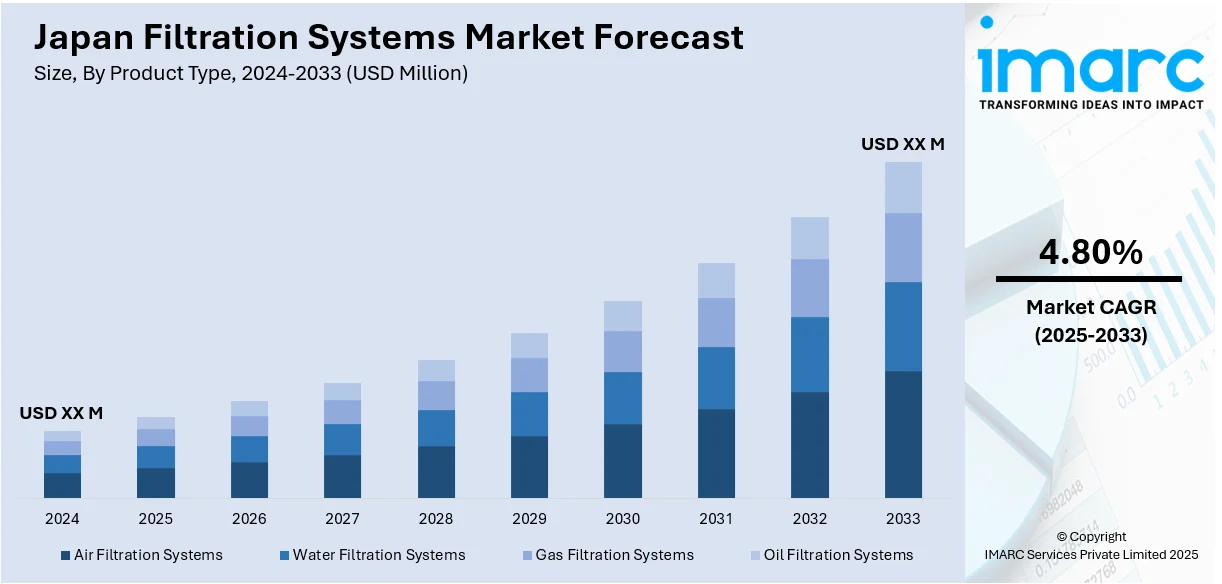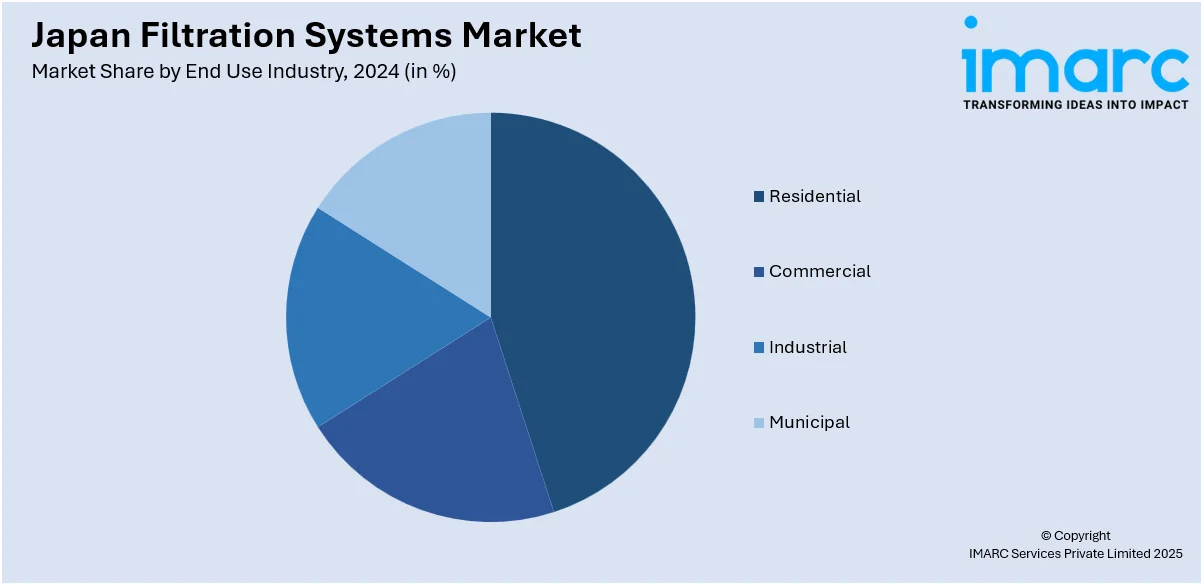
Japan Filtration Systems Market Size, Share, Trends and Forecast by Product Type, Filter Media, Technology, End Use, and Region, 2025-2033
Japan Filtration Systems Market Overview:
The Japan filtration systems market size is projected to exhibit a growth rate (CAGR) of 4.80% during 2025-2033. The market is driven by the growing urbanization and the resulting demand for clean air and water in compact living spaces. Rising health awareness is pushing consumers toward advanced filtration technologies for both residential and commercial use. Environmental regulations are encouraging industries to adopt sustainable filtration solutions. Additionally, Japan’s focus on smart home integration and energy efficiency is boosting the adoption of innovative, Internet of Things (IoT)-enabled systems. These combined factors are bolstering the Japan filtration systems market share across both consumer and industrial segments.
|
Report Attribute
|
Key Statistics
|
|---|---|
|
Base Year
|
2024
|
|
Forecast Years
|
2025-2033
|
|
Historical Years
|
2019-2024
|
| Market Growth Rate 2025-2033 | 4.80% |
Japan Filtration Systems Market Trends:
Smart and Compact Filtration Technologies
In Japan, where residential spaces are usually limited, there is increasing need for small filtration systems that can integrate well into home and office settings. Consumers also prefer smart products that provide more control and convenience. Latest filtration systems today are equipped with app connectivity, real-time monitoring, and automatic maintenance alerts, enabling users to better control air and water quality. Small air purifiers and water filters are also being made with dual functions, such as purification plus humidification or deodorizing capabilities. Design is not only about functionality but also aesthetics and usability, with most units now designed to blend well with modern home decor. The intersection of technology, design, and functionality is fueling Japan filtration systems market growth, particularly among city dwellers who seek smart and efficient home products.

Focus on Sustainability and Energy Efficiency
Sustainability is becoming a center value in Japan's filtration systems industry. Consumers and businesses alike are going out of their way to obtain goods that help minimize environmental footprints without sacrificing performance. This trend can be seen in the creation of environmentally friendly air and water filtration systems made from recyclable materials or featuring reusable filters. Energy-efficient systems are also on the rise, saving households and industries power consumption. Businesses are placing a growing focus on long-term cost reduction and minimized waste, appealing to a value-based society that prizes resourcefulness and environmental stewardship. Even packaging and production of products are seeing a wave toward green approaches. This is part of a wider national consciousness regarding sustainability, affirming Japan's adherence to responsible consumption. Consequently, the market is experiencing an increase in brands that espouse cleaner, greener technology without compromising on filtration and functionality levels.
Industrial Adoption of Advanced Filtration
Industries across Japan are embracing sophisticated filtration systems to align with stricter environmental standards and efficiency goals. From manufacturing to agriculture, businesses are implementing advanced solutions to improve water reuse, manage waste, and maintain clean production environments. Modern industrial filters now integrate automated systems and smart sensors, enabling better monitoring and real-time adjustments. These innovations help minimize downtime, reduce costs, and ensure consistent compliance with environmental regulations. In sectors where cleanliness and water quality are critical, such as food production or electronics, advanced filtration has become an operational necessity. Beyond compliance, many companies also view these systems as part of their broader sustainability strategy. By adopting high-performance, durable filtration technologies, industries in Japan are not only enhancing productivity but also contributing to the national vision of sustainable growth and environmental stewardship.
Japan Filtration Systems Market Segmentation:
IMARC Group provides an analysis of the key trends in each segment of the market, along with forecasts at the country and regional levels for 2025-2033. Our report has categorized the market based on product type, filter media, technology and end use.
Product Type Insights:
- Air Filtration Systems
- Water Filtration Systems
- Gas Filtration Systems
- Oil Filtration Systems
The report has provided a detailed breakup and analysis of the market based on the product type. This includes air filtration systems, water filtration systems, gas filtration systems, and oil filtration systems.
Filter Media Insights:
- Activated Carbon
- Fiberglass
- Nonwoven Fabrics
- Metals
- Filter Paper
- Combination Filters
- Others
A detailed breakup and analysis of the market based on the filter media have also been provided in the report. This includes activated carbon, fiberglass, nonwoven fabrics, metals, filter paper, combination filters, and others.
Technology Insights:
- Microfiltration
- Ultrafiltration
- Nanofiltration
- Reverse Osmosis
- Electrodialysis
- Chromatography
- Centrifugation
The report has provided a detailed breakup and analysis of the market based on the technology. This includes microfiltration, ultrafiltration, nanofiltration, reverse osmosis, electrodialysis, chromatography, and centrifugation.
End Use Industry Insights:

- Residential
- Commercial
- Industrial
- Municipal
A detailed breakup and analysis of the market based on the end use industry have also been provided in the report. This includes residential, commercial, industrial, and municipal.
Regional Insights:
- Kanto Region
- Kansai/Kinki Region
- Central/ Chubu Region
- Kyushu-Okinawa Region
- Tohoku Region
- Chugoku Region
- Hokkaido Region
- Shikoku Region
The report has also provided a comprehensive analysis of all the major regional markets, which include Kanto, Kansai/Kinki, Central/ Chubu, Kyushu-Okinawa, Tohoku, Chugoku, Hokkaido, and Shikoku Region.
Competitive Landscape:
The market research report has also provided a comprehensive analysis of the competitive landscape. Competitive analysis such as market structure, key player positioning, top winning strategies, competitive dashboard, and company evaluation quadrant has been covered in the report. Also, detailed profiles of all major companies have been provided.
Japan Filtration Systems Market News:
- In March 2025, Murata Manufacturing launched "CELLNETTA," the world’s first metal cell fractionation filter designed for rapid and precise selection of target cells from suspensions. This innovation supports regenerative medicine and cell pharmaceutical research by improving cell fractionation, concentration, and filtration. CELLNETTA aims to accelerate research and development in regenerative therapies and biotechnology sectors like agriculture and energy. It will be showcased at the Japanese Society for Regenerative Medicine meeting in March 2025.
- In February 2025, Asahi Kasei and Kurashiki City have launched a biogas purification system at the Kojima Sewage Treatment Plant in Japan. Using zeolite-based CO₂ separation and pressure vacuum swing adsorption (PVSA) technology, the system extracts high-purity methane from biogas. It aims to support carbon-neutral energy by converting sewage sludge into biomethane for electricity. The trial also explores carbon capture potential, with commercialization expected by 2027 following further evaluations.
Japan Filtration Systems Market Report Coverage:
| Report Features | Details |
|---|---|
| Base Year of the Analysis | 2024 |
| Historical Period | 2019-2024 |
| Forecast Period | 2025-2033 |
| Units | Million USD |
| Scope of the Report |
Exploration of Historical Trends and Market Outlook, Industry Catalysts and Challenges, Segment-Wise Historical and Future Market Assessment:
|
| Product Types Covered | Air Filtration Systems, Water Filtration Systems, Gas Filtration Systems, Oil Filtration Systems |
| Filter Medias Covered | Activated Carbon, Fiberglass, Nonwoven Fabrics, Metals, Filter Paper, Combination Filters, Others |
| Technologies Covered | Microfiltration, Ultrafiltration, Nanofiltration, Reverse Osmosis, Electrodialysis, Chromatography, Centrifugation |
| End Uses Covered | Residential, Commercial, Industrial, Municipal |
| Regions Covered | Kanto Region, Kansai/Kinki Region, Central/ Chubu Region, Kyushu-Okinawa Region, Tohoku Region, Chugoku Region, Hokkaido Region, Shikoku Region |
| Customization Scope | 10% Free Customization |
| Post-Sale Analyst Support | 10-12 Weeks |
| Delivery Format | PDF and Excel through Email (We can also provide the editable version of the report in PPT/Word format on special request) |
Key Questions Answered in This Report:
- How has the Japan filtration systems market performed so far and how will it perform in the coming years?
- What is the breakup of the Japan filtration systems market on the basis of product type?
- What is the breakup of the Japan filtration systems market on the basis of filter media?
- What is the breakup of the Japan filtration systems market on the basis of technology?
- What is the breakup of the Japan filtration systems market on the basis of end use?
- What is the breakup of the Japan filtration systems market on the basis of region?
- What are the various stages in the value chain of the Japan filtration systems market?
- What are the key driving factors and challenges in the Japan filtration systems market?
- What is the structure of the Japan filtration systems market and who are the key players?
- What is the degree of competition in the Japan filtration systems market?
Key Benefits for Stakeholders:
- IMARC’s industry report offers a comprehensive quantitative analysis of various market segments, historical and current market trends, market forecasts, and dynamics of the Japan filtration systems market from 2019-2033.
- The research report provides the latest information on the market drivers, challenges, and opportunities in the Japan filtration systems market.
- Porter's five forces analysis assist stakeholders in assessing the impact of new entrants, competitive rivalry, supplier power, buyer power, and the threat of substitution. It helps stakeholders to analyze the level of competition within the Japan filtration systems industry and its attractiveness.
- Competitive landscape allows stakeholders to understand their competitive environment and provides an insight into the current positions of key players in the market.
Need more help?
- Speak to our experienced analysts for insights on the current market scenarios.
- Include additional segments and countries to customize the report as per your requirement.
- Gain an unparalleled competitive advantage in your domain by understanding how to utilize the report and positively impacting your operations and revenue.
- For further assistance, please connect with our analysts.
 Request Customization
Request Customization
 Speak to an Analyst
Speak to an Analyst
 Request Brochure
Request Brochure
 Inquire Before Buying
Inquire Before Buying




.webp)




.webp)












